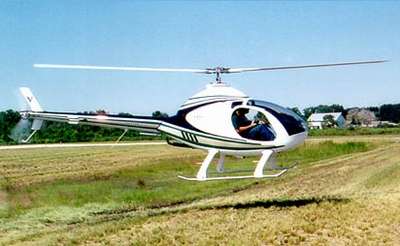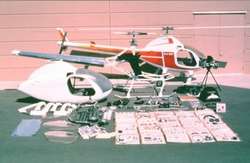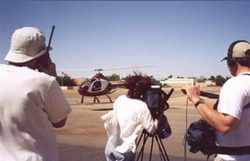Not Everyone Can Say That...
by ANN Correspondent Pete Tobin
Each and every summer, the attendees of the Oshkosh air show are
treated to fantastic "thinking outside the box" designs for new
aircraft created by ambitious aeronautical engineers who hope to
revolutionize general aviation. Uniquely enough, a large percentage
of those impressive designs will be either for rotorcrafts or
vertical take-off and landing vehicles.

The next summer will roll around; and, you never see any of
those aircraft again.
But, each and every summer, Oshkosh attendees are consistently
rewarded with an equally wowing display and flight demonstration of
the Rotorway Exec helicopter. If you walk the flight line each
summer, you’ll see several brand new Exec’s that
didn’t exist the summer before. Rotorway never goes away.
It’s a well thought out, and functional design.
 The genesis of the Exec
began in 1961 when the late B.J. Schramm followed a path that many
before and since have tried which led him to create a very
affordable personal aircraft that anyone with a modest amount of
skill can build, maintain and fly. Hopefully, this aircraft would
have vertical take-off and landing capabilities.
The genesis of the Exec
began in 1961 when the late B.J. Schramm followed a path that many
before and since have tried which led him to create a very
affordable personal aircraft that anyone with a modest amount of
skill can build, maintain and fly. Hopefully, this aircraft would
have vertical take-off and landing capabilities.
The original "plans-built" Scorpion I helicopter grew into the
Scorpion II. Then, in the early 80’s, B.J. started with a
blank sheet of paper and reworked not only his concept for an
aircraft, but also his entire company and began producing a
complete kit for what is now called the Exec. Unable to find an
engine supplier, nor other components to his liking, Schramm
elected to manufacture nearly the entire kit himself. Not only was
everything you needed to build the helicopter, except the paint,
delivered to your workshop door in vacuum sealed packages, but more
than 80% of the parts, including the engine, were manufactured
under Schramm’s own roof.
It was a bold idea. It worked. Schramm came home from Oshkosh
1980 with the EAA’s coveted Outstanding New Design trophy.
Customers responded in droves. The company grew.

In 1990, a British Rotorway customer named John Netherwood
purchased the company creating Rotorway International. His first
order of business was to sit down with each of his new employees
and listen to every idea about how to improve the already
outstanding design. Netherwood rethought everything from the
helicopter itself, to the assembly manuals, down to the packaging
of the parts. The stem-to-stern rework of the helicopter evolved
into the Exec 90 and introduced the RI 162 cubic inch engine
turning asymmetrical rotor blades.
Builders responded to the changes positively, buying more and
more kits; and, the line outside the door at Rotorway grew even
longer.
Not willing to rest on this success, Netherwood retooled the
carburetor into a fuel injection system computer controlled (FADEC)
system. This, and many other improvements were modeled into the
Exec 162F. Customers now had the ability to download information
from the FADEC and e-mail that data to the Rotorway technicians,
who could diagnose, tune and adjust engine functions for an Exec
helicopter located anywhere in the world. In 1994, Netherwood made
the thoughtful choice of selling his company back to his employees
who had worked so hard redefining the design, before moving back to
England.

Rotorway International has never taken the attitude of: "if it
ain’t broke, don’t fix it." Even today, the engineers
in Chandler, AZ are implementing design enhancements; the most
recent being, an Altitude Compensation Induction System (ACIS)
which allows for sea level performance at high altitudes than ever
before.
"What made me fly the helicopter was affordability," said Ed
DeRossi, who has built three Execs for himself and has performed
the maiden flights for more than 100 other Exec builders. "Anyone
can afford to build it and maintain it. Unless you have a really
large checkbook, you’re not going to find a nicer
helicopter."
 If the "proof is in the
pudding" standard for any kit aircraft is how many kits are sold,
do they actually fly; and, do they come home from Oshkosh with
trophies? The answer is yes!
If the "proof is in the
pudding" standard for any kit aircraft is how many kits are sold,
do they actually fly; and, do they come home from Oshkosh with
trophies? The answer is yes!
Since 1990, more than 1,100 Exec kits have been shipped to eager
builders. One or two Exec owners have been invited up to the trophy
table at Oshkosh’s AirVenture or Sun 'N Fun nearly every year
since the Exec first hit the market. The bulk of the time, they
take home the Golden Lindy.
When asked about this, EAA Spokesman, Dick Knapinski stated:
"The Rotorway has done very well at the EAA Airventure because of a
few factors. One is that Rotorway attracts dedicated enthusiastic
builders who are meticulous about doing things right. Another is
that the design is solid and meets all the criteria that the judges
at Oshkosh are looking for. Added to that is the safety of the
design and it’s functionality. It continues to be one of the
most popular homebuilt rotorcraft designs".
In this writer’s personal opinion... the Exec is a
flat-out good-looking, good-sounding helicopter.
 Airbus Racer Helicopter Demonstrator First Flight Part of Clean Sky 2 Initiative
Airbus Racer Helicopter Demonstrator First Flight Part of Clean Sky 2 Initiative Diamond's Electric DA40 Finds Fans at Dübendorf
Diamond's Electric DA40 Finds Fans at Dübendorf ANN's Daily Aero-Term (04.23.24): Line Up And Wait (LUAW)
ANN's Daily Aero-Term (04.23.24): Line Up And Wait (LUAW) NTSB Final Report: Extra Flugzeugbau GMBH EA300/L
NTSB Final Report: Extra Flugzeugbau GMBH EA300/L Classic Aero-TV: 'Never Give Up' - Advice From Two of FedEx's Female Captains
Classic Aero-TV: 'Never Give Up' - Advice From Two of FedEx's Female Captains







